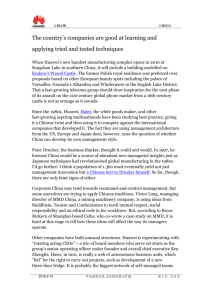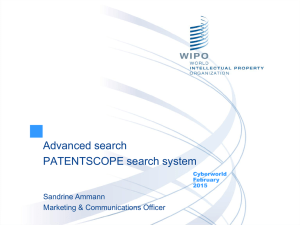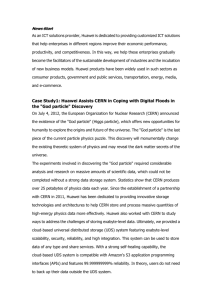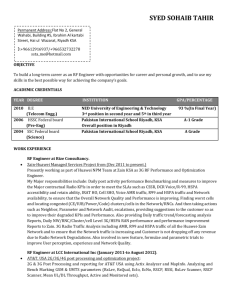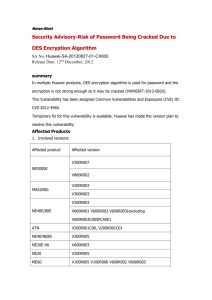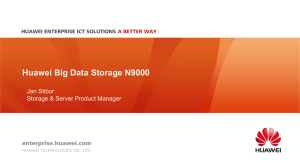Cell C “BEAM”
advertisement
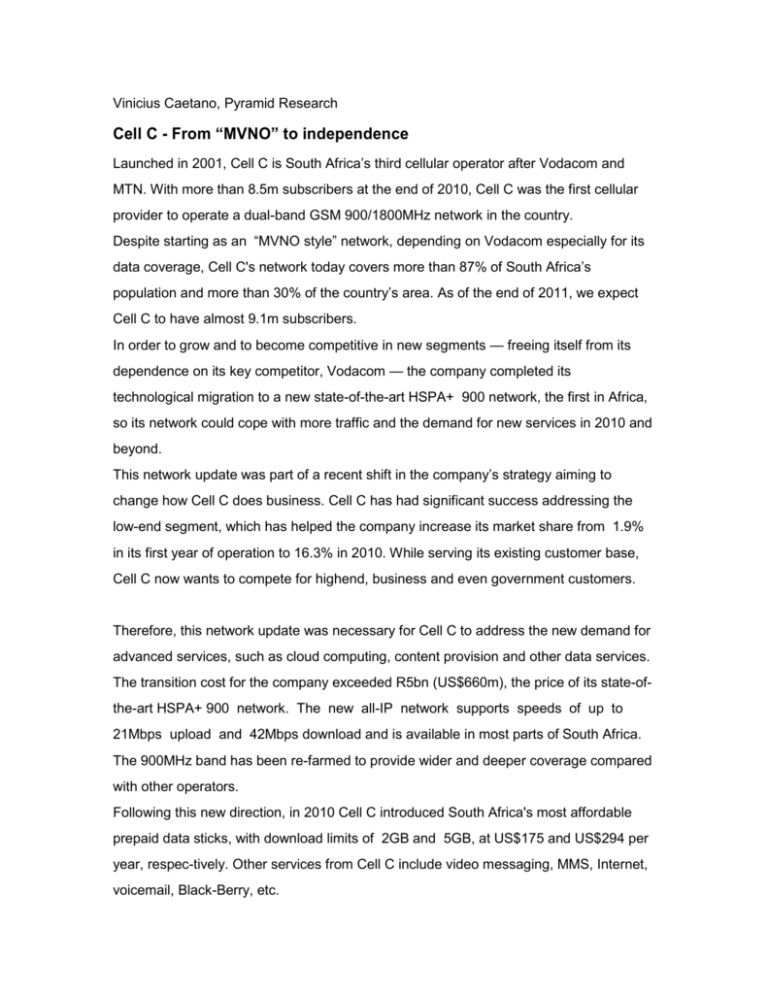
Vinicius Caetano, Pyramid Research Cell C - From “MVNO” to independence Launched in 2001, Cell C is South Africa’s third cellular operator after Vodacom and MTN. With more than 8.5m subscribers at the end of 2010, Cell C was the first cellular provider to operate a dual-band GSM 900/1800MHz network in the country. Despite starting as an “MVNO style” network, depending on Vodacom especially for its data coverage, Cell C's network today covers more than 87% of South Africa’s population and more than 30% of the country’s area. As of the end of 2011, we expect Cell C to have almost 9.1m subscribers. In order to grow and to become competitive in new segments — freeing itself from its dependence on its key competitor, Vodacom — the company completed its technological migration to a new state-of-the-art HSPA+ 900 network, the first in Africa, so its network could cope with more traffic and the demand for new services in 2010 and beyond. This network update was part of a recent shift in the company’s strategy aiming to change how Cell C does business. Cell C has had significant success addressing the low-end segment, which has helped the company increase its market share from 1.9% in its first year of operation to 16.3% in 2010. While serving its existing customer base, Cell C now wants to compete for highend, business and even government customers. Therefore, this network update was necessary for Cell C to address the new demand for advanced services, such as cloud computing, content provision and other data services. The transition cost for the company exceeded R5bn (US$660m), the price of its state-ofthe-art HSPA+ 900 network. The new all-IP network supports speeds of up to 21Mbps upload and 42Mbps download and is available in most parts of South Africa. The 900MHz band has been re-farmed to provide wider and deeper coverage compared with other operators. Following this new direction, in 2010 Cell C introduced South Africa's most affordable prepaid data sticks, with download limits of 2GB and 5GB, at US$175 and US$294 per year, respec-tively. Other services from Cell C include video messaging, MMS, Internet, voicemail, Black-Berry, etc. Cell C is owned by 3C Telecommunications, which is 60% owned by Oger Telecom South Africa, a division of Saudi Oger; 25% owned in an unencumbered holding by CellSAf, a Broad-Based Black Economic Empowerment entity representing more than 30 black empowerment compa-nies and trusts; and 15% by Lanun Securities SA, a wholly owned subsidiary of Saudi Oger Ltd. Exhibit 1: Mobile subscriptions market share in South Africa, 2010 Source: Pyramid Research, operators How does the third operator compete in a mobile market? South Africa is a country with a developed mobile communications market. Mobile subscriptions in the country are expected to surpass 55m in 2011, which translates into a penetration rate of 108% of the population (Exhibit 2). Exhibit 2: Mobile subscriptions and penetration in South Africa, 2004-2011 Source: Pyramid Research Not only is the market in South Africa developed, but it is also very competitive. The country has two incumbent mobile operators, Vodacom and MTN, which have had a presence in South Africa since the rollout of mobile communications. In the past 10 years, two new and aggressive companies joined the market: Cell C, a completely new entrant, and Telkom, the mobile arm of South Africa’s incumbent fixed-line operator. In order to compete against the more established companies, the new entrants, especially Cell C, knew that their success would not only rely on attracting new customers but also current clients from the competition. For these new entrants to succeed, their offer would have to have enough appeal to change South Africa’s market dynamics and attract users in all tiers of spending and service usage. Cell C was aware of this challenge from the beginning. Since being extremely competitive was always an element of its strategy, in its first years of operation, the company decided to focus its strategy on price-sensitive customers who were at the moment not served by any other operator in South Africa. However, in order to sustain significant growth and become a major operator, Cell C shifted its strategy and started focusing on attracting high-end and even business customers by offering high-value services at competitive prices. Examples of new offers coming from this shift in strategy include offers to prepaid customers that evolved from 10 free extra airtime minutes for every R10 (accumulated) spent on recharg-ing to more sophisticated promotions, such as one in which for every R1 a customer recharged, he or she received 10MB of data, 1 SMS and 1 free minute, for charges of at least R50. In 2010, Cell C also introduced South Africa's most affordable prepaid data plans, with download limits of 2GB and 5GB, at US$175 and US$294 a year, respectively. While these plans have been successful in accelerating subscriber growth, they also placed greater demands on the Cell C network. These demands were not only related to the traffic generated by the free minutes and free data — which was solved with the deployment of the HSPA+ network —but also to the structure needed to keep track of all these extra benefits, as well as their usage and correct billing. With the imbalances and delays generated by the 128 different IT platforms being used by Cell C and many gateways among them, marketing strategies and operations began to disconnect. The company’s IT system could not handle the needs of this young and fast-paced company, which is why Cell C decided to upgrade its IT infrastructure. Time to market was among the many issues the legacy systems created. Cell C knew that in order to attract new clients, its products had to be timed correctly, and innovations couldn’t take too long because its services and products had to remain attractive compared with its competitors. However, the time it took to implement these new services was fluctuating between three and six months, while the ideal was to have ongoing implementation repeatability of three months or less. Besides the long time to market, other problems related to the old systems included: faulty billing, lack of visibility of clients’ activities and usage among many different payment methods (prepaid, postpaid, hybrid) and difficulties in implementing new promotions due to the need to adapt them to several systems. Cell C “BEAM”- The introduction of a new BSS solution from Huawei In order to become more competitive and address the new segments by way of the revised product and service value proposition, Cell C took the next step to improve its time to market and level of service. For that, the company decided to migrate from its more than 128 existing IT systems to a platform designed by a single provider, eliminating the need for gateways and the recurrent adaptations they required, which were slowing down the company. As the implementation of the NGBSS would literally beam Cell C into a new future, the project was called “BEAM.” Speed became a very crucial element to Cell C’s strategy. Not only did Cell C decide to implement a new BSS solution, but it also decided that this transition needed to happen at a very fast pace. Cell C would only sign a contract with a provider that could agree to implement the solution within a six-month time frame (from the initial Cell C requirements specification to cutover). It also required that the actual cutover to the new NGBSS system be a one-time migration event over a single weekend, minimizing any problems it might create. After clearly identifying its needs and requirements, Cell C consulted with several renowned BSS providers for the solution that would best meet its needs. However, Huawei was the only company that could actually deliver a solution that closely met Cell C’s requirements within the demanding delivery time frame. Huawei went the extra mile to understand the business challenges caused by Cell C’s service convergence and rising customer sophistication. By leveraging its extensive telecommunications and IT expertise and in-depth benchmarking analyses of Cell C's current business and operations, Huawei supported Cell C's business and strategic IT transformation through the delivery of an end-to-end NGBSS solution. The solution was implemented based on the application of industry best practices, including customer relationship management (CRM), IP contact center (IPCC), convergent billing system (CBS), mediation and provisioning coupled to a single integration platform. As mentioned before, one of the concerns raised by Cell C was the time taken to implement the new system. Aside from the actual implementation, the company also required all existing products, services and customers to be migrated from their legacy system into the new system, all within the same aggressive delivery time frame. Both Huawei and Cell C understood that this would represent the world’s first brownfield migration of an entire BSS system within the time frame proposed. In order to comply with Cell C’s requirements, Huawei went through detailed planning, executing several dry runs and data migration testing. The actual delivery of the NGSS system took 11 months total, and while this was longer than the originally contracted delivery period, it remains a world first. The project delays were accepted in order to provide additional business assurance about service functionality, as well as to provide assurance through additional cutover readiness preparation. In summary, the project was delivered in less than one year and the cutover took no longer than 18 hours, with the overall impact of the migration on customer experience kept to a minimum. After extensive testing, the cutover process was executed along a strict timetable on Saturday, Feb. 5, 2011, with the actual transfer of services taking just five hours, leading into six hours of post-migration testing. Cell C shops and retail outlets were back online doing business by noon on Sunday, Feb. 6, 2011, after closing at normal business hours on Saturday. The contin-ued post-cutover support allowed Cell C to make smooth progress in the final post-cutover steps, resulting, as mentioned, in minimal impact to its clients. All business-critical issues (i.e., those related to customer operations and service lines) were resolved in the first two weeks after the cutover. It is also important to mention that this successful transition was made possible not only by Huawei’s commitment to its client, but also by Cell C’s own commitment to the new strategy. “The full engagement of Cell C’s executive team in this transition speeded up the process and allowed for the migration to happen as quickly and as smoothly as possible,” said Michael An-sley, the program director for BEAM and also the company’s executive in Business Partnerships. This full commitment was also embraced by Cell C’s marketing team, which launched a PR campaign. The objective was to inform all of Cell C’s customers of the transitions the company was undergoing and what they should expect from the new Cell C after they were completed. This strategy had a very positive impact and generated a lot of trust among Cell C’s customers, which certainly helped to minimize any possible client churn. Ansley also highlighted the importance of Huawei’s technical expertise and transparency during the process. Also integral to the success was a very competent Cell C program management team, who developed a real-time migration dashboard through which Huawei and Cell C had full visibility of hundreds of migration-related activities and schedules taking place throughout the cutover process. “It helped Cell C not only to understand all of the steps and challenges of the process, but also to effectively (and in real time) to plan for and communicate changes to migration team mem-bers, key partners and vendors, executives and business stakeholders spread countrywide,” said Ansley. Exhibit 3: Key success factors for the NGBSS implementation at Cell C Source: Pyramid Research Faster decision making and innovation ― a potent combination After a successful implementation, Huawei’s NGBSS solution now provides Cell C with many capabilities that the company didn’t have before. Taking advantage of an integrated single vendor solution, Cell C can now make better and faster decisions and bring new products and services to market faster. With the NGBSS, Cell C is able to generate accurate and real-time usage data for its postpaid, prepaid and hybrid services, making network planning faster and easier. Also, Cell C can now offer a single bill for all services, in contrast to having to process data from multiple IT platforms, which often resulted in several bills. The total number of IT vendors was reduced from more than 15 to 3, the interface types from more than 10 to 4, the number of databases from 68 to 25, and the number of ESB buses from 3 to 1. Billing problems, which were a major complaint among Cell C customers, have been signifi-cantly reduced. After the implementation, this issue barely exists and is no longer a concern for the South African operator. The average service provisioning time has been reduced from 1.5 hours to 6 minutes. Unified customer care and products have been realized, and customer complaints have been substantially reduced. The new system has also been allowing Cell C to launch innovative and unique products and services in a timely fashion. The new system provides deeper configuration capabilities than the legacy IT systems, with significant opex savings expected through 2012 and beyond. For instance, the time to market for new services used to take weeks but now takes days in most cases. It is important to mention, though, that the whole process is still not finished, and Huawei and Cell C are still working together to unleash all the benefits that the NGBSS can provide to Cell C. With the new network and the NGBSS, Cell C is no longer an also-ran in the South African mar-ket but is now recognized as one of the boldest operators in the country, offering many data and voice plans that suit the needs of the most advanced users without having to charge a high premium. From a marketing perspective, the transition was also very positive for Cell C. Since the beginning of the NGBSS implementation, Cell C opted to make the process public, using several media channels to interact with its clients and inform them of what was happening on its network and what clients should expect before and after this process. During the actual switchover, there were several ads in place warning clients that the network could face some instability and not work properly during that process (see Exhibit 4). Cell C preferred to adopt a strategy of clear communication so clients could understand that any potential problem would be a consequence of a one-time event that would positively impact the company’s services for years to come. Cell C’s strategy paid off. Not only did the company benefit from the flawless transition between the old system and the new NGBSS, but clients felt more connected to company, believing that they participated in this important step. Exhibit 4: Call C ad alerting customers to a one-time network upgrade



